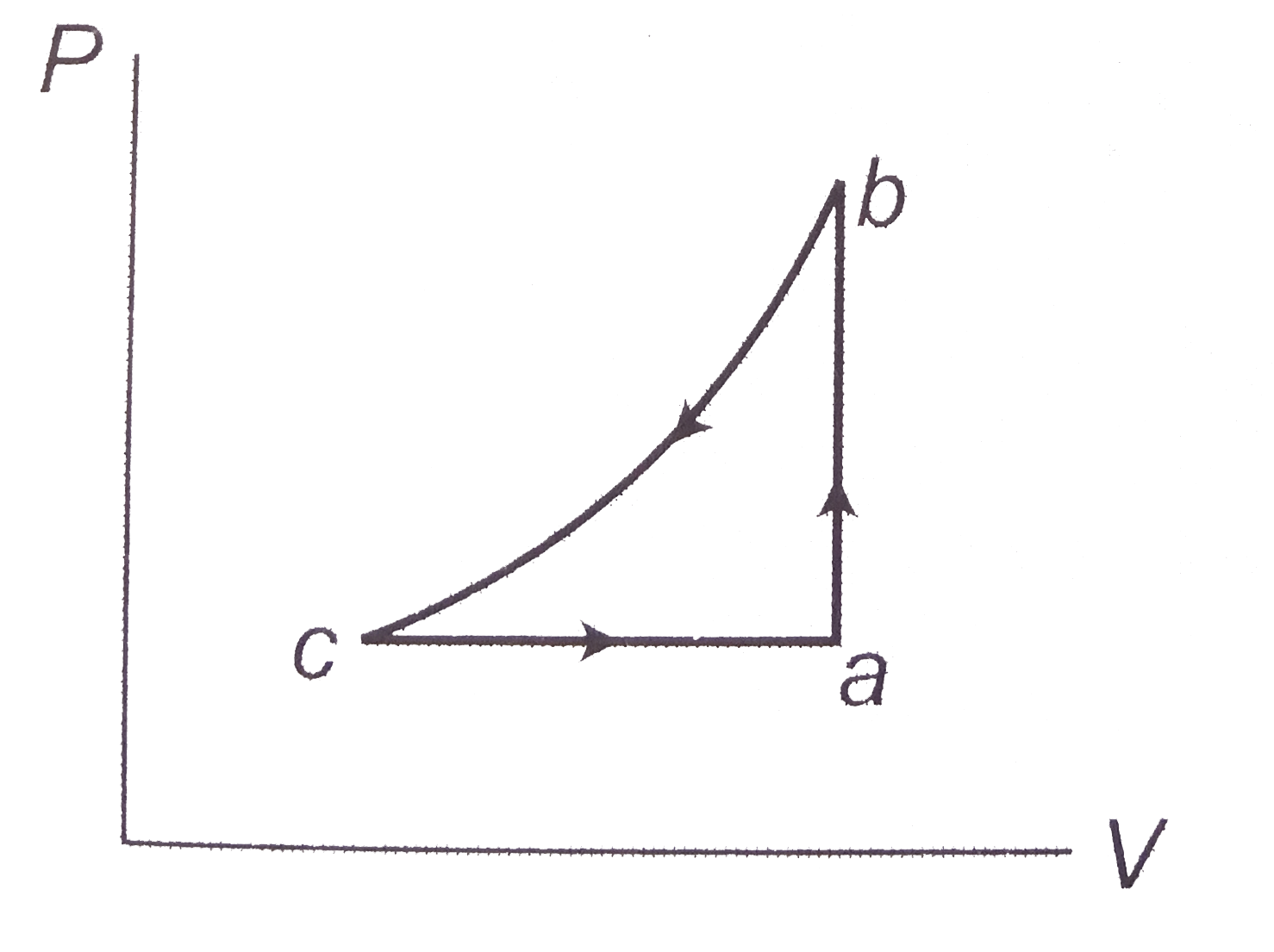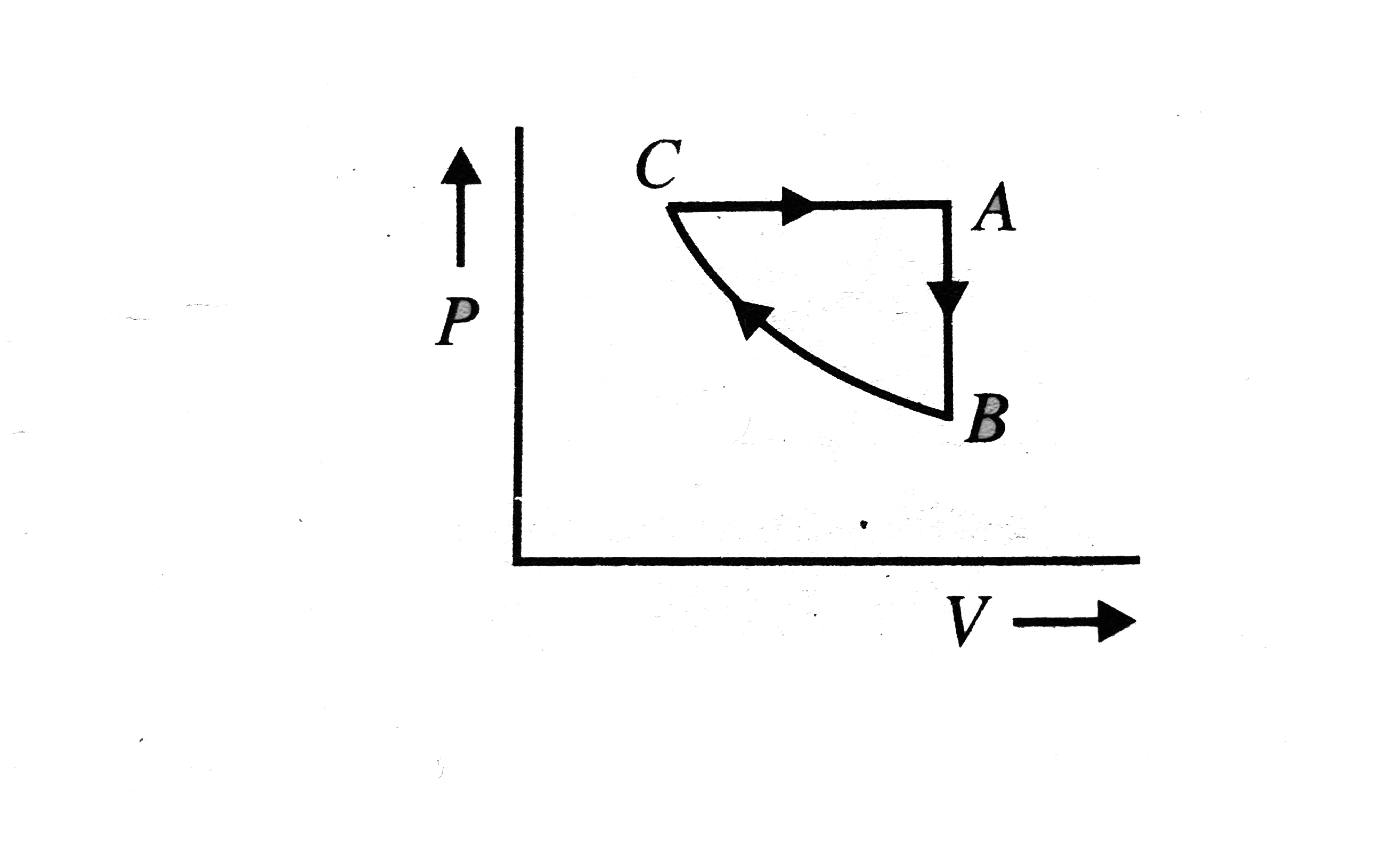A sample of an ideal gas is taken through the cyclic process abca . It absorbs 50J of heat during the part ab, no heat during bc and rejects 70J of heat during ca. 40J of work is done on the gas during the part bc.
(a) Find the internal energy of the gas at b and c if it is 1500J at a.
(b) Calculate the work done by the gas during the part ca.

1590J
1620J
1540J
1570J
The correct Answer is:A
ΔWAB=0 as V=constant
∴ΔQAB=ΔUAB=50J (given )
UA=1500J∴UB=(1500+50)J=1550J
ΔWBC=−ΔUBC=−40J (Given)
∴ΔUBC=40J∴UC=(1550+40)J=1590J.
Topper's Solved these Questions
- KINETIC THEORY OF GASES AND THERMODYNAMICSBOOK - A2ZCHAPTER - KINETIC THEORY OF GASES AND THERMODYNAMICSEXERCISE - Second Law Of Thermodynamics
29 Videos
- KINETIC THEORY OF GASES AND THERMODYNAMICSBOOK - A2ZCHAPTER - KINETIC THEORY OF GASES AND THERMODYNAMICSEXERCISE - Problems Based On Mixed Concepts
49 Videos
- KINETIC THEORY OF GASES AND THERMODYNAMICSBOOK - A2ZCHAPTER - KINETIC THEORY OF GASES AND THERMODYNAMICSEXERCISE - First Law Of Thermodynamics , Internal Energy And Work Done
55 Videos
- GRAVITATIONBOOK - A2ZCHAPTER - GRAVITATIONEXERCISE - Chapter Test
29 Videos
- MOCK TESTBOOK - A2ZCHAPTER - MOCK TESTEXERCISE - Motion With Constant Acceleration
15 Videos
Similar Questions

A sample of an ideal gas in taken through the cyclic process abca in the given figure. It absorbs 50 J of heat during the parth ab, no heat during bc and rejects 70J of heat during ca, 40 J of work is done on the gas during the part bc.
(a) Find the internal energy of the gas at b adn c if it is 1500 J at a. ltbr> (b) Calculate the work done by the gas during the part ca.
View SolutionIn figure, a sample of an ideal gas is taken through the cyclic process abca. 800J of work is done by the gas during process ab. If gas absorb no heat in process ab, rejects 100J of heat during bc and absord 500J of heat during process ca. Then (a) find the internal energy of the gas at b and c if its is 1000J at a (b). Also calculate the work by the gas during the part bc,

View Solution
Knowledge Check
A sample of an ideal gas is taken through the cyclic-process ABCA shown in Fig. It rejects 50J of heat during the part AB, doens not absorb or reject the heat during BC, and accepts 70J of heat during CA. Forty joules of works is done on the gas during the part BC. The internla energies at B and C, respectively, will be
 A1450J and 1410JB1550J and 1590JC1450J and 1490JD1550J and 1510J
A1450J and 1410JB1550J and 1590JC1450J and 1490JD1550J and 1510J
A sample of an ideal gas is taken through the cyclic process abca and shown in the figure. The chagne in the internal energy of the gas along the path ca is −180J. The gas aborbs 250J of heat along the path ab and 60 J along the path bc. the work done by the along the path abc is:A120JB130JC100JD140J
In a process, 701J of heat is absorbed by a system and 394J of work is done by the system. What is the change in internal energy for the process?
View SolutionIn a process, 701 J of heat is absorbed by a system and 394 J of work is done by the system.What is the change in internal energy for the process?
View SolutionIn a process, 701J of heat is absorbed by a system and 394J of work is done by the system. What is the change in internal energy for the process?
View SolutionIn a process, 701J of heat is absorbed by a system and 394J of work is done by the system. What is the change in internal energy for the process?
View SolutionA gas is taken through a cyclic process ABCA as shown in, if 2.4 cal of heat is given in the process, what is the value of J ?

View SolutionA system works in a cyclic process. It absorbs 20 calories of heat and rejects 60J of heat during the process. The magnitude of work done (J) is [1calorie=4.2J]:
View Solution
